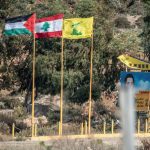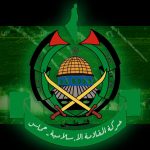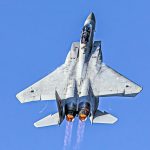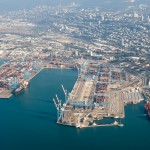As Hezbollah Buries Nasrallah, Israel Releases New Footage of His Assassination
Jerusalem, 23 February, 2025 (TPS-IL) -- As Hezbollah staged a funeral for Hassan Nasrallah, Israel released new footage of his September assassination as well as photos of Air Force jets overflying Beirut in what Defense Minister Israel Katz said was a message to Israel’s enemies.
“The Israeli Air Force planes currently circling in the skies of Beirut over Hassan Nasrallah’s funeral are sending a clear message: Whoever threatens to destroy Israel and attacks Israel – that will be his end,” Katz said in a statement.
“You will specialize in funerals – and we in victories,” Katz added.
Footage of the strike showed a jet dropping seven bombs on the Beirut building where Nasrallah’s underground bunker was located, triggering a series of explosions. The Israeli Air Force dropped 82 bombs.
Also on Sunday, Israeli jets struck Hezbollah rocket launchers in the southern Lebanese area of Tyre. On Saturday night, the IDF confirmed striking Lebanon-Syria border crossings where Hezbollah was smuggling weapons in violation of the ceasefire.
Tens of thousands of Lebanese thronged to Camille Chamoun Sports City Stadium and surrounding streets for the funerals of Nasrallah and his would-be successor, Hashem Safieddine. The latter was killed in a separate October airstrike.
Nasrallah was killed in a strike on his underground bunker in Beirut along with other senior Hezbollah commanders on Sept. 27.
During his 32 years at the top of Hezbollah, Nasrallah was responsible for the murder of numerous Israeli civilians and soldiers, planning and executing thousands of terrorist actions against Israeli citizens and others around the world. He served as the central decision-maker of all strategic decisions within the terrorist organization.
Hezbollah’s most notable terror attacks under Nasrallah’s leadership included the 1994 truck bombing at the Buenos Aires Jewish community headquarters, killing 85; the 1996 suicide bombing of the Khobar Towers in Saudi Arabia, which killed 19 U.S. servicemen; the 2000 abduction of Israeli businessman Elhanan Tanenbaum after luring him to Dubai for a drug deal; the 2005 assassination of Lebanese Prime Minister Rafik Hariri in a car bombing, which killed another 22 people.
In 2006, Hezbollah launched a cross-border raid, abducting two soldiers and killing eight more, triggering the Second War in Lebanon. The war ended when Hezbollah and Israel accepted UN Security Resolution 1701, which demanded Hezbollah’s disarming south of the Litani River. Nasrallah lived underground for the rest of his life.
In 2012, Hezbollah blew up an Israeli tour bus in the Bulgarian city of Burgas, killing six people and injuring 32.
Since 1992, Hezbollah also attempted to carry out attacks that were ultimately thwarted in Turkey, Thailand, Azerbaijan, India, Georgia, and Bulgaria.
Under the terms of a two-month ceasefire that went into effect on November 27 and has since been extended, Hezbollah is supposed to withdraw its armed presence from areas of southern Lebanon south of the Litani River. Israeli forces have withdrawn from most of southern Lebanon. Dissatisfied with the Lebanese army’s deployment, Israel is keeping soldiers in five locations with US approval.







